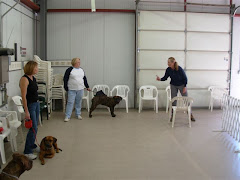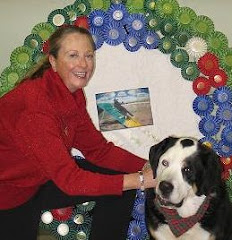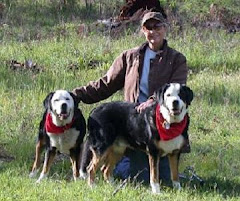 What it means:
What it means:
Curb means Don't go any further. Stop your forward movement.
Most common use:
At a door. You don't want your dog to bolt out the door when you open it, so you tell him to "Curb," which means don't go past the threshold or door frame.
What it does:
It keeps the dog safely behind the door until you have control of the situation and release him from his "curb" position.
Other applications:
Keeping a dog from jumping into or out of a car before you're ready; keeping a dog temporarily in (or out of) one room in the house while you are nearby; keeping the dog from bolting into the house before you wipe his feet; keeping the dog from jumping right over you to get out when you open the kennel door; teaching the dog that you, the leader, have the right to go FIRST through any door.
How to teach it:
Have the dog on a correction collar (choke chain) and a six-foot leash, held loosely in your hands.
Bring the dog up to a closed door. Do NOT ask him to sit. Do NOT use the word "Stay." In a normal but strong tone of voice, tell him, "Curb! Currrrrb." As you say this, wave your extended arm and open palm down in front of him, as if you are drawing a line on the floor--a line you don't want your dog to cross. Your arm motion should be like a clock pendulum. Look at the dog as you are saying the command and waving your arm. Give him the opportunity to think about it, but don't worry if he doesn't seem to understand, or even if he's not paying attention to you. (He will probably be focused on getting out the door when you crack it open.)
Hold onto the leash handle, but let the slack drop to the floor. Open the door and take one confident step across the threshold. Your dog will probably follow you. As soon as you see he has placed one foot over the threshold (and past the invisible "curb line" you drew with your arm), bump him back inside (or pull him back inside with a sharp and harsh tug of the leash) as you say "NO! Currrrb!" Repeat the arm signal.
If you sufficiently surprised (and startled) your dog by the sharp correction, he will heed you this time when you say "Currrb!" Give the command, wave your arm, drop the slack in the leash, and once again take a bold step outside. Your dog will PROBABLY not follow you this time. IMMEDIATELY step back inside and praise him exuberantly, "Good Curb! What a good dog!" and let him know he did the right thing.
Practice the curb the same way two more times at the same door. You should see your dog's confidence and knowledge visibly grow with each repetition. Next, move on to other doors and teach him the same thing.
If, however, your dog is still unclear, and if he threatens to step over the line or comes close to doing so, your correction should be quicker and harsher than it was the first time. Keep emotion out of it. Don't whine. Be decisive. Make it easy for your dog to CHOOSE to "curb."
Do not hold your dog back with the leash when you're teaching the curb. Let the dog have the slack in the leash so that he can make the mistake. He MUST make the mistake before he can be corrected for it, and he MUST be corrected before he can adequately learn what "curb" means.
If you have to correct him more than 2 times at any given door, your technique (timing, strength of correction, etc.) is off.
The correction you give your dog for breaking a "curb" should duplicate (in timing and intensity) the type of shock you would get if you touched an electric fence with the intent of climbing over it. The correction must be IMMEDIATE (as you make contact with the electric wire) and it must make an indelible impression on you so that you never want to grab an electric fence again.
If you want your dog to be good at front-door curbs, you MUST set him up. Have neighbor kids or friends come to the door for the sole purpose of "baiting" your dog and helping you train the curb. If you wait until real company or the real UPS man comes, you will be too distracted to adequately watch, correct, and discipline your dog...and then the dog will learn that your commands mean nothing.
Another good way to use the curb is to help YOU get through a door BEFORE your dog does. Remember that Leader always goes first in a real pack situation. It's a courtesy and a sign of respect. So...to reinforce your status as Leader in your house, make the dog "curb" in doorways. You step through the doorway and then immediately (and happily) release your dog to come through with you. Your release word will probably be "Okay!" Do not use "Come" as a release word, because it's a command for a different action. Your release word should be something used specifically for ending an exercise. Again, "Okay!" works very well.
Practice curbing at EVERY door you encounter with your dog, EVERY time. Use it at car doors, tailgates, crate doors, dining room doors, tops or bottoms of steps, and much more. It is the most versatile command, and the easiest one to teach. It will also keep your dog mentally alert to your commands.
Follow the steps above, and you should be able to teach your dog the "curb" command in about seven seconds. If you're having trouble, go back and read the rest of this post again.


















No comments:
Post a Comment